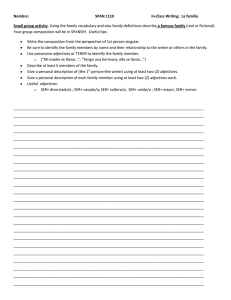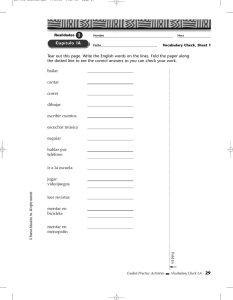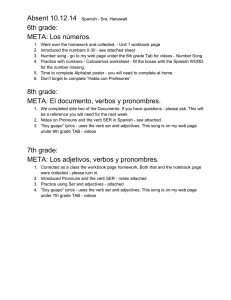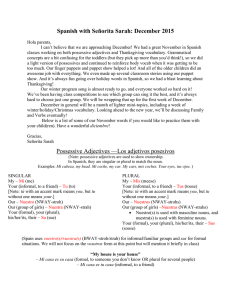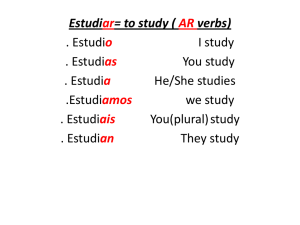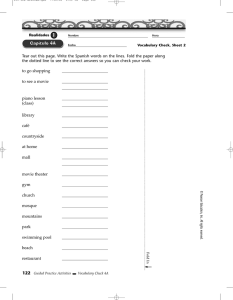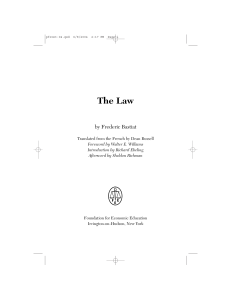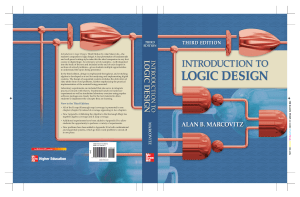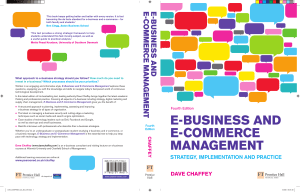The plurals of adjectives
Anuncio
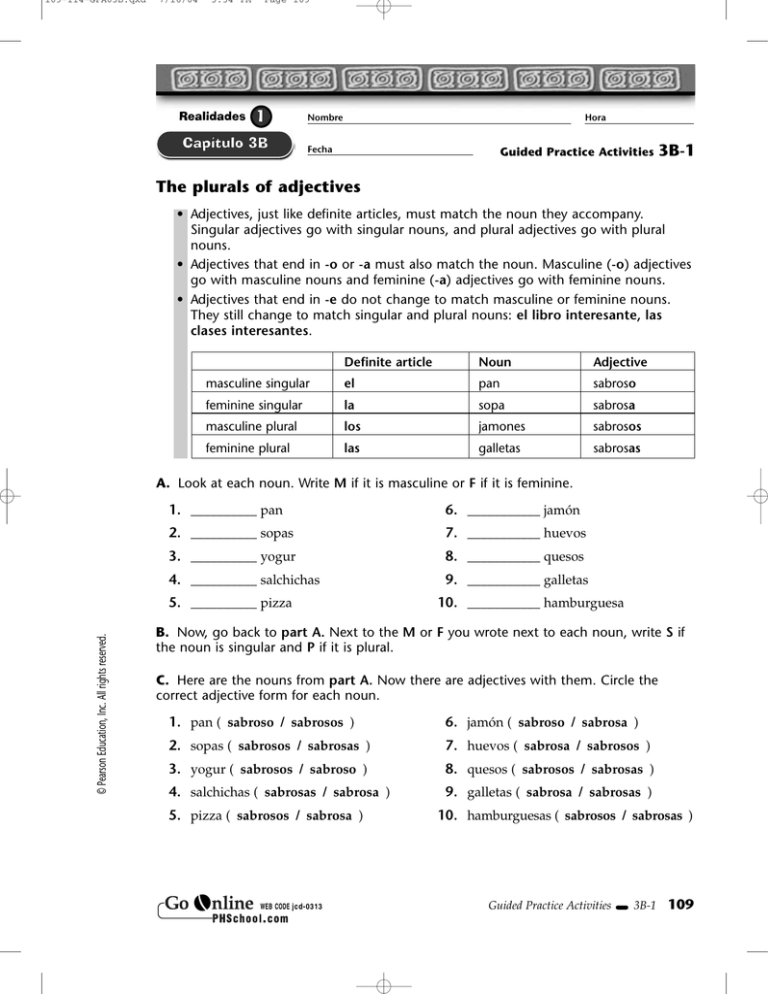
109-114-GPA03B.qxd 7/16/04 5:54 PM Page 109 Realidades Nombre Hora Fecha Guided Practice Activities 3B-1 The plurals of adjectives • Adjectives, just like definite articles, must match the noun they accompany. Singular adjectives go with singular nouns, and plural adjectives go with plural nouns. • Adjectives that end in -o or -a must also match the noun. Masculine (-o) adjectives go with masculine nouns and feminine (-a) adjectives go with feminine nouns. • Adjectives that end in -e do not change to match masculine or feminine nouns. They still change to match singular and plural nouns: el libro interesante, las clases interesantes. Definite article Noun Adjective masculine singular el pan sabroso feminine singular la sopa sabrosa masculine plural los jamones sabrosos feminine plural las galletas sabrosas A. Look at each noun. Write M if it is masculine or F if it is feminine. 1. __________ pan 6. ___________ jamón 2. __________ sopas 7. ___________ huevos 3. __________ yogur 8. ___________ quesos 4. __________ salchichas 9. ___________ galletas © Pearson Education, Inc. All rights reserved. 5. __________ pizza 10. ___________ hamburguesa B. Now, go back to part A. Next to the M or F you wrote next to each noun, write S if the noun is singular and P if it is plural. C. Here are the nouns from part A. Now there are adjectives with them. Circle the correct adjective form for each noun. 1. pan ( sabroso / sabrosos ) 6. jamón ( sabroso / sabrosa ) 2. sopas ( sabrosos / sabrosas ) 7. huevos ( sabrosa / sabrosos ) 3. yogur ( sabrosos / sabroso ) 8. quesos ( sabrosos / sabrosas ) 4. salchichas ( sabrosas / sabrosa ) 9. galletas ( sabrosa / sabrosas ) 5. pizza ( sabrosos / sabrosa ) WEB CODE jcd- 0313 10. hamburguesas ( sabrosos / sabrosas ) Guided Practice Activities 3B-1 109 109-114-GPA03B.qxd 7/16/04 Realidades 5:54 PM Page 110 Nombre Hora Guided Practice Activities Fecha 3B-2 The plurals of adjectives (continued) D. Fill in the missing singular or plural form of each masculine adjective in the chart. Masculine singular plural divertido simpático atrevidos serios artístico E. Now, fill in the missing singular or plural form of each feminine adjective in the chart. Feminine singular plural divertidas simpática atrevidas seria artísticas serio atrevido artístico seria atrevida artística serios atrevidos artísticos serias atrevidas artísticas 1. Laura y Elena estudian mucho. Son ______________________. 2. Sandra monta en monopatín. Es ______________________. 3. Mario dibuja. Es ______________________. 4. Tomás y Beatriz trabajan mucho. Son ______________________. 5. Lorenzo y Fernando esquían. Son ______________________. 110 Guided Practice Activities 3B-2 WEB CODE jcd- 0313 © Pearson Education, Inc. All rights reserved. F. Choose an adjective from the group of words. Write its correct form in the space provided. 109-114-GPA03B.qxd 7/16/04 5:54 PM Page 111 Realidades Nombre Hora Fecha Guided Practice Activities 3B-3 The verb ser • You have already learned and used some forms of the verb ser, which means to be: Yo soy serio. Tú eres simpática. Ella es artística. • Ser is an irregular verb. You will need to memorize its forms. yo soy nosotros/nosotras somos tú eres vosotros/vosotras sois usted/él/ella es ustedes/ellos/ellas son A. Choose the correct subject pronoun for each form of ser and circle it. 1. ( yo / él ) es 5. ( usted / tú ) es 2. ( ustedes / ella ) son 6. ( nosotros / ellas ) son 3. ( tú / ella ) eres 7. ( ellos / nosotros ) somos 4. ( ella / yo ) es 8. ( yo / él ) soy B. Now, write the correct form of ser next to each subject pronoun. 1. tú __________________________________ 5. ellas _____________________________ 2. usted _______________________________ 6. nosotras __________________________ 3. ellos _______________________________ 7. yo _______________________________ 4. él __________________________________ 8. ustedes ___________________________ © Pearson Education, Inc. All rights reserved. C. Complete the exchanges by writing in the correct form of ser. 1. 2. 3. 4. VERA: Yo _______________ estudiante. ¿Y tú? GONZALO: Yo _______________ estudiante también. PABLO: Tú _______________ muy deportista, ¿no? ENRIQUE: Sí, pero yo también _______________ muy estudioso. INÉS: Susana y Olivia _______________ muy divertidas. MARCOS: Sí. Olivia _______________ muy simpática también. PACO Y LUIS: Nosotros _______________ perezosos. No estudiamos mucho. ANA: Bueno, yo _______________ muy trabajadora. Me gusta estudiar. WEB CODE jcd- 0314 Guided Practice Activities 3B-3 111 109-114-GPA03B.qxd 7/16/04 Realidades 5:54 PM Page 112 Nombre Hora Guided Practice Activities Fecha 3B-4 The verb ser (continued) D. Look at each drawing. Complete the question with a form of ser. Follow the model. Modelo ¿Cómo es él? ¿Cómo _____________________ él? 2. ¿Cómo _____________________ tú? 3. ¿Cómo _____________________ ellas? 4. ¿Cómo _____________________ nosotras? 5. ¿Cómo _____________________ yo? E. Now, complete each sentence with the correct form of ser and the correct adjective ending. Refer back to the art in part D. Follow the model. Modelo Él es simpático . 1. Él ___________________ artístic______. 2. Tú ___________________ perezos______. 3. Ellas ___________________ estudios______. 4. Nosotras ___________________ inteligente_____. 5. Yo ___________________ atrevid______. 112 Guided Practice Activities 3B-4 WEB CODE jcd- 0314 © Pearson Education, Inc. All rights reserved. 1. 109-114-GPA03B.qxd 7/16/04 5:54 PM Page 113 Realidades Nombre Hora Fecha Guided Practice Activities 3B-5 Lectura: La comida de los atletas Skimming is a useful technique to help you get through a reading. You think of general information that you are looking for. Then you quickly read the words to find it. A. List three things you would expect to find in an article about an athlete’s eating habits. 1. ____________________________________________________________________________ 2. ____________________________________________________________________________ 3. ____________________________________________________________________________ B. Skim the article and check off the things in your list from part A that you find. C. Note that the pie chart in your textbook shows how much of an athlete’s diet can be divided into three categories. Next to each category below, write the English translation of the word. Then fill in the percentage number according to the pie chart. © Pearson Education, Inc. All rights reserved. English Number 1. carbohidratos _____________________ ___________ % 2. proteínas _____________________ ___________ % 3. grasas _____________________ ___________ % D. The reading in your textbook gives a picture and a short description of what foods are good for each big meal of the day. Next to each food given below circle whether the reading says it is best for D (desayuno), A (almuerzo), or C (cena). 1. D A C pan con mantequilla 4. D A C papas 2. D A C pasta 5. D A C jalea 3. D A C yogur E. Read the selection below and answer the questions that follow. La noche antes del partido, el jugador bebe un litro de jugo de naranja, y durante el partido bebe hasta dos litros de agua y bebidas deportivas. 1. Circle the three kinds of drinks mentioned in the reading. 2. What is a litro in English? ____________________ 3. When does the player drink a litro of orange juice? ________________________ WEB CODE jcd- 0315 Guided Practice Activities 3B-5 113 109-114-GPA03B.qxd 7/16/04 Realidades 5:54 PM Page 114 Nombre Hora Guided Practice Activities Fecha 3B-6 Presentación escrita Task: You will make a poster in Spanish with three suggestions for better health. You will need to research what are proven good eating and exercise habits. 1 Prewrite. Talk to classmates, teachers, the school nurse, or your parents about ● good eating and exercise habits, especially for teens. Then list their ideas under the following headings to help you organize your information: • Debes comer _______________________________________________________________. • No debes comer mucho(a) ___________________________________________________. • Debes beber _______________________________________________________________. • No debes beber mucho(a) ___________________________________________________. • Debes ________________________________________________ para mantener la salud. 2 Draft. ● Create your first draft on a separate sheet of paper. (You do not need to use posterboard for this draft.) List your ideas from the prewrite stage. Organize them in a neat or artistic way. Sketch out the visuals you want to include on the poster. 3 Revise. ● A. Someone else will check your work for the following: ______ Have you communicated the three suggestions well? ______ Do the visuals help with the meaning? ______ Will the visuals make the poster attractive? ______ Are all words spelled correctly? B. Rewrite your poster using the person’s suggestions. 4 Publish. Your final draft will be on some sort of posterboard. You will want to ● carefully add any illustrations and designs you had sketched out in an earlier stage. 5 Evaluate. ● will check: Your teacher will tell you how your poster will be graded. Your teacher • your completion of the task • the accuracy of your vocabulary and grammar • your effective use of visuals 114 Guided Practice Activities 3B-6 © Pearson Education, Inc. All rights reserved. ______ Are grammar and vocabulary used correctly?
